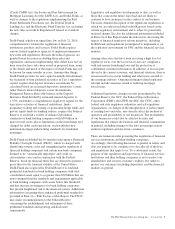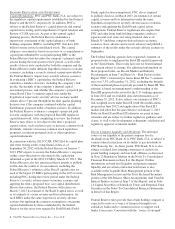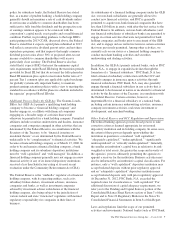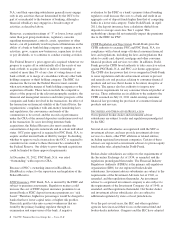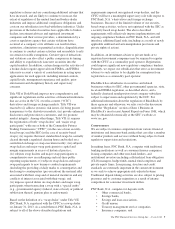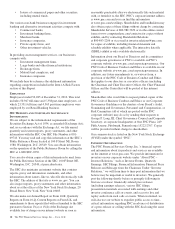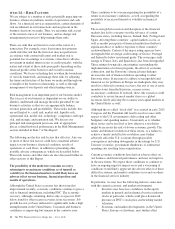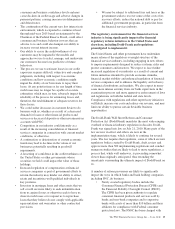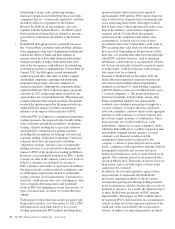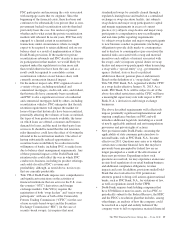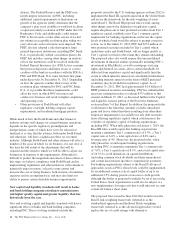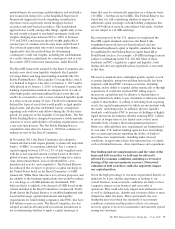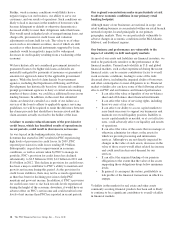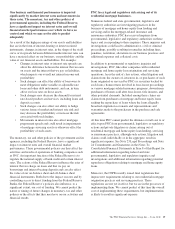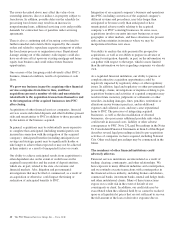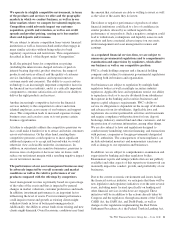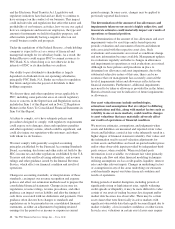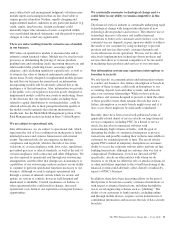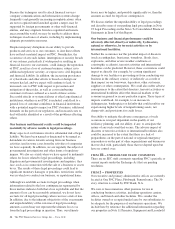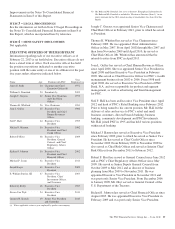PNC Bank 2012 Annual Report Download - page 34
Download and view the complete annual report
Please find page 34 of the 2012 PNC Bank annual report below. You can navigate through the pages in the report by either clicking on the pages listed below, or by using the keyword search tool below to find specific information within the annual report.PNC participates and increasing the costs associated
with mortgage assets that we originate. Since the
beginning of the financial crisis, there has been and
continues to be substantially less private (that is, non-
government backed) securitization activity than had
previously been the case. It is unclear at present
whether and to what extent the private securitization
markets will rebound. In recent years, PNC has only
engaged to a limited extent in securitization
transactions under circumstances where we might
expect to be required to retain additional risk on our
balance sheet as a result of implementation of these
Dodd-Frank provisions. If the market for private
securitizations rebounds and PNC decides to increase
its participation in that market, we would likely be
required under the regulations to retain more risk
than would otherwise have been the case, and as a
result could be required to consolidate certain
securitization vehicles on our balance sheet, with
currently an uncertain financial impact.
• On the indirect impact side, PNC originates loans of
a variety of types, including residential and
commercial mortgages, credit card, auto, and student,
that historically have commonly been securitized,
and PNC is also a significant servicer of residential
and commercial mortgages held by others, including
securitization vehicles. PNC anticipates that the risk
retention requirements will impact the market for
loans of types that historically have been securitized,
potentially affecting the volumes of loans securitized,
the types of loan products made available, the terms
on which loans are offered, consumer and business
demand for loans, and the need for third-party loan
servicers. It should be noted that the risk retention
rules themselves could have the effect of slowing the
rebound in the securitization markets. One effect of
having substantially reduced opportunities to
securitize loans would likely be a reduction in the
willingness of banks, including PNC, to make loans
due to balance sheet management requirements. Any
of these potential impacts of the Dodd-Frank risk
retention rules could affect the way in which PNC
conducts its business, including its product offerings,
and could also affect PNC’s revenue and
profitability, although, as noted above, not in ways
that are currently predictable.
• Title VII of Dodd-Frank imposes new comprehensive
and significant restrictions on the activities of
financial institutions that are active in the U.S. over-
the-counter (“OTC”) derivatives and foreign
exchange markets. Title VII (i) requires the
registration of both “swap dealers” and “major swap
participants” with one or both of the Commodity
Futures Trading Commission (“CFTC”) (in the case
of non security-based swaps) and the Securities
Exchange Commission (“SEC”) (in the case of
security-based swaps); (ii) requires that most
standardized swaps be centrally cleared through a
regulated clearing house and traded on a centralized
exchange or swap execution facility; (iii) subjects
swap dealers and major swap participants to capital
and margin requirements in excess of current
practice; (iv) subjects swap dealers and major swap
participants to comprehensive new recordkeeping
and real-time public reporting requirements;
(v) subjects swap dealers and major swap participants
to new business conduct requirements (including an
obligation to provide daily marks to counterparties
and to disclose to counterparties (pre-execution) the
material risks associated with a swap and material
incentives and conflicts of interest associated with
the swap); and (vi) imposes special duties on swap
dealers and major swap participants when transacting
a swap with a “special entity” (e.g., governmental
agency (federal, state or local) or political
subdivision thereof, pension plan or endowment).
Based on the definition of a “swap dealer” under
Title VII, PNC Bank, N.A. registered with the CFTC
as a swap dealer effective January 31, 2013. As a
result, PNC Bank, N.A. will be subject to all of the
above-described restrictions and the CFTC will have
a meaningful supervisory role with respect to PNC
Bank, N.A.’s derivatives and foreign exchange
businesses.
The above described requirements will collectively
impose potentially significant implementation and
ongoing compliance burdens on PNC and will
introduce additional legal risk (including as a result
of newly applicable antifraud and anti-manipulation
provisions and private rights of action).
• New provisions under Dodd-Frank concerning the
applicability of state consumer protection laws to
national banks, such as PNC Bank, N.A., became
effective in 2011. Questions may arise as to whether
certain state consumer financial laws that may have
previously been preempted by federal law are no
longer preempted as a result of the effectiveness of
these new provisions. Depending on how such
questions are resolved, we may experience an increase
in state-level regulation of our retail banking business
and additional compliance obligations, revenue
impacts and costs. In addition, provisions under Dodd-
Frank that also took effect in 2011 permit state
attorneys general to bring civil actions against national
banks, such as PNC Bank, N.A., for violations of law,
as well as regulations issued by the CFPB.
• Dodd-Frank requires bank holding companies that
have $50 billion or more in assets, such as PNC, to
periodically submit to the Federal Reserve, the FDIC
and the FSOC a resolution plan that includes, among
other things, an analysis of how the company could
be resolved in a rapid and orderly fashion if the
company were to fail or experience material financial
The PNC Financial Services Group, Inc. – Form 10-K 15


